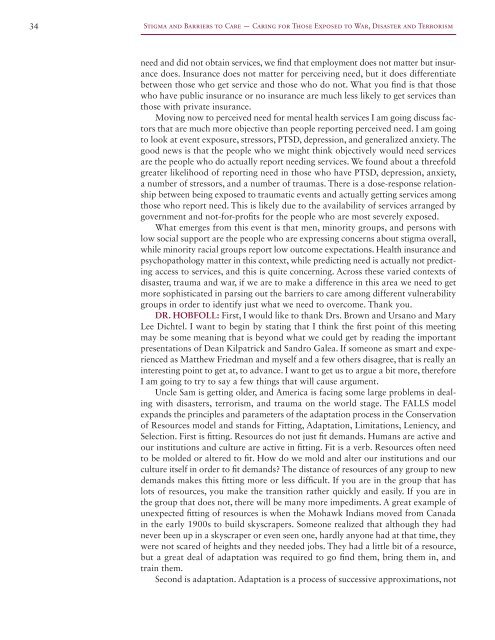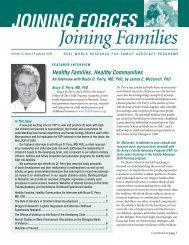stigma and barriers to care - Uniformed Services University of the ...
stigma and barriers to care - Uniformed Services University of the ...
stigma and barriers to care - Uniformed Services University of the ...
You also want an ePaper? Increase the reach of your titles
YUMPU automatically turns print PDFs into web optimized ePapers that Google loves.
34<br />
Stigma <strong>and</strong> Barriers <strong>to</strong> Care — Caring for Those Exposed <strong>to</strong> War, Disaster <strong>and</strong> Terrorism<br />
need <strong>and</strong> did not obtain services, we find that employment does not matter but insurance<br />
does. Insurance does not matter for perceiving need, but it does differentiate<br />
between those who get service <strong>and</strong> those who do not. What you find is that those<br />
who have public insurance or no insurance are much less likely <strong>to</strong> get services than<br />
those with private insurance.<br />
Moving now <strong>to</strong> perceived need for mental health services I am going discuss fac<strong>to</strong>rs<br />
that are much more objective than people reporting perceived need. I am going<br />
<strong>to</strong> look at event exposure, stressors, PTSD, depression, <strong>and</strong> generalized anxiety. The<br />
good news is that <strong>the</strong> people who we might think objectively would need services<br />
are <strong>the</strong> people who do actually report needing services. We found about a threefold<br />
greater likelihood <strong>of</strong> reporting need in those who have PTSD, depression, anxiety,<br />
a number <strong>of</strong> stressors, <strong>and</strong> a number <strong>of</strong> traumas. There is a dose-response relationship<br />
between being exposed <strong>to</strong> traumatic events <strong>and</strong> actually getting services among<br />
those who report need. This is likely due <strong>to</strong> <strong>the</strong> availability <strong>of</strong> services arranged by<br />
government <strong>and</strong> not-for-pr<strong>of</strong>its for <strong>the</strong> people who are most severely exposed.<br />
What emerges from this event is that men, minority groups, <strong>and</strong> persons with<br />
low social support are <strong>the</strong> people who are expressing concerns about <strong>stigma</strong> overall,<br />
while minority racial groups report low outcome expectations. Health insurance <strong>and</strong><br />
psychopathology matter in this context, while predicting need is actually not predicting<br />
access <strong>to</strong> services, <strong>and</strong> this is quite concerning. Across <strong>the</strong>se varied contexts <strong>of</strong><br />
disaster, trauma <strong>and</strong> war, if we are <strong>to</strong> make a difference in this area we need <strong>to</strong> get<br />
more sophisticated in parsing out <strong>the</strong> <strong>barriers</strong> <strong>to</strong> <strong>care</strong> among different vulnerability<br />
groups in order <strong>to</strong> identify just what we need <strong>to</strong> overcome. Thank you.<br />
DR. HOBFOLL: First, I would like <strong>to</strong> thank Drs. Brown <strong>and</strong> Ursano <strong>and</strong> Mary<br />
Lee Dichtel. I want <strong>to</strong> begin by stating that I think <strong>the</strong> first point <strong>of</strong> this meeting<br />
may be some meaning that is beyond what we could get by reading <strong>the</strong> important<br />
presentations <strong>of</strong> Dean Kilpatrick <strong>and</strong> S<strong>and</strong>ro Galea. If someone as smart <strong>and</strong> experienced<br />
as Mat<strong>the</strong>w Friedman <strong>and</strong> myself <strong>and</strong> a few o<strong>the</strong>rs disagree, that is really an<br />
interesting point <strong>to</strong> get at, <strong>to</strong> advance. I want <strong>to</strong> get us <strong>to</strong> argue a bit more, <strong>the</strong>refore<br />
I am going <strong>to</strong> try <strong>to</strong> say a few things that will cause argument.<br />
Uncle Sam is getting older, <strong>and</strong> America is facing some large problems in dealing<br />
with disasters, terrorism, <strong>and</strong> trauma on <strong>the</strong> world stage. The FALLS model<br />
exp<strong>and</strong>s <strong>the</strong> principles <strong>and</strong> parameters <strong>of</strong> <strong>the</strong> adaptation process in <strong>the</strong> Conservation<br />
<strong>of</strong> Resources model <strong>and</strong> st<strong>and</strong>s for Fitting, Adaptation, Limitations, Leniency, <strong>and</strong><br />
Selection. First is fitting. Resources do not just fit dem<strong>and</strong>s. Humans are active <strong>and</strong><br />
our institutions <strong>and</strong> culture are active in fitting. Fit is a verb. Resources <strong>of</strong>ten need<br />
<strong>to</strong> be molded or altered <strong>to</strong> fit. How do we mold <strong>and</strong> alter our institutions <strong>and</strong> our<br />
culture itself in order <strong>to</strong> fit dem<strong>and</strong>s The distance <strong>of</strong> resources <strong>of</strong> any group <strong>to</strong> new<br />
dem<strong>and</strong>s makes this fitting more or less difficult. If you are in <strong>the</strong> group that has<br />
lots <strong>of</strong> resources, you make <strong>the</strong> transition ra<strong>the</strong>r quickly <strong>and</strong> easily. If you are in<br />
<strong>the</strong> group that does not, <strong>the</strong>re will be many more impediments. A great example <strong>of</strong><br />
unexpected fitting <strong>of</strong> resources is when <strong>the</strong> Mohawk Indians moved from Canada<br />
in <strong>the</strong> early 1900s <strong>to</strong> build skyscrapers. Someone realized that although <strong>the</strong>y had<br />
never been up in a skyscraper or even seen one, hardly anyone had at that time, <strong>the</strong>y<br />
were not s<strong>care</strong>d <strong>of</strong> heights <strong>and</strong> <strong>the</strong>y needed jobs. They had a little bit <strong>of</strong> a resource,<br />
but a great deal <strong>of</strong> adaptation was required <strong>to</strong> go find <strong>the</strong>m, bring <strong>the</strong>m in, <strong>and</strong><br />
train <strong>the</strong>m.<br />
Second is adaptation. Adaptation is a process <strong>of</strong> successive approximations, not




